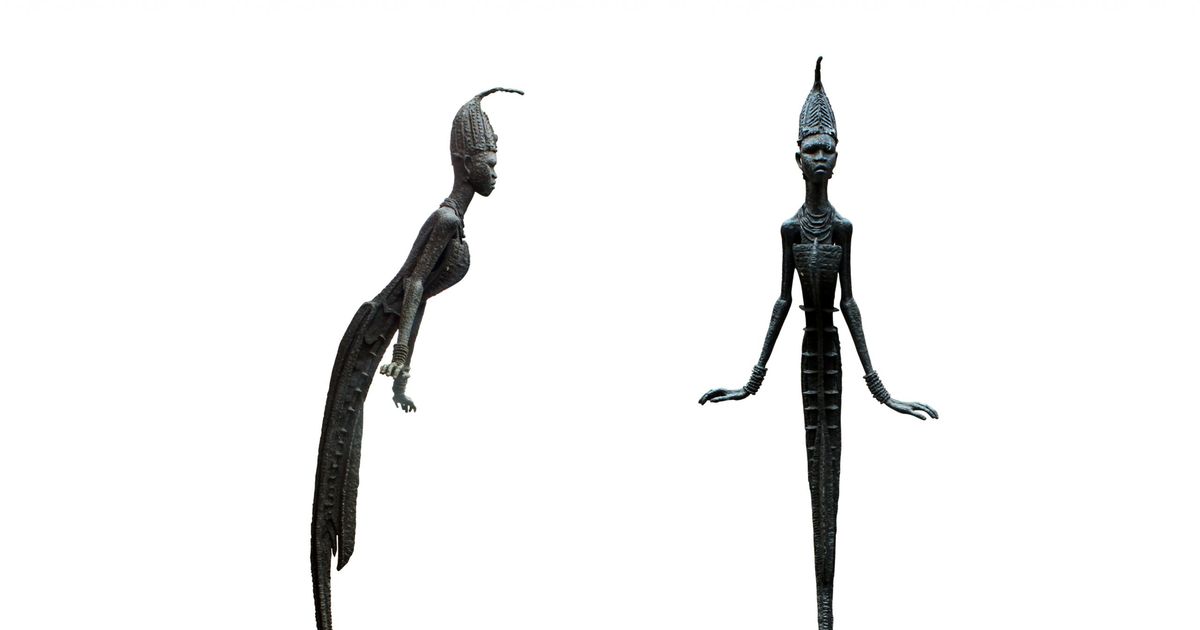
An edition of the magnum opus of Nigerian modernist Ben Enwonwu, Anyanwu, sold at a Bonhams auction last month for £237,750 (with fees), beyond its estimate of £180,000. But what many people don’t realise is the interesting back story and huge cultural significance the work has in Nigeria and the wider African community.
Anyanwu was originally created in a life-size cast in 1954-55 as a commission for the Nigerian government to commemorate the establishment of the National Museum in Lagos, before its independence in 1960. In October 1966, Enwonwu was invited to reproduce the work, this time for the United Nations headquarters in New York—a move by the Nigerian government to burnish its reputation as a leading, newly independent nation, ready to take charge in the global community.
Enwonwu’s sculpture subsequently became so well known that the artist produced several smaller editions which, decades later, are now something of an auction favourite, fiercely fought for in sales and typically fetching hundreds of thousands of pounds. At least four different editions—cast in bronze, sometimes with golden patination—have appeared in the past five years in auctions at Bonhams and Sotheby’s. They have also appeared in Nigerian sales, such as Arthouse Contemporary, where it broke the record in 2012 for the most expensive work of art sold at auction in Nigeria when it fetched £110,000 (with fees). Each time a work appears on the market it is attended by fanfare, only for it to go quietly into the possession of its new owner to be hardly discussed again until the appearance of another example.
The significance of Anyanwu
Anyanwu symbolises the powerful earth goddess Ani, who is worshipped by the Igbo group from which the artist hails; and for whom there was previously no physical image. It is emblematic of rich sculptural traditions and figuration in Igbo culture and Benin history, respectively.
The feminine form depicted in the piece, lithe and seemingly in movement, manifests two ideas. First, it pays homage to the Negritude movement, founded in the 1930s by Francophone intellectuals, which criticised colonialism and the cultural domination of Western powers and insisted on pride in blackness and African heritage. The form in Anyanwu articulates dance as a unique African expression that Enwonwu would go on to explore throughout his career.
“[Anyanwu] defined the aspirations of the African people. It is still very relevant when it comes to the advancement of black people, in today’s racial discourse. The message of the work is more pertinent than ever,” explains the artist’s son Oliver Enwonwu.
The second idea that the sculpture brings forth is the female form as mother and nourisher of the emerging, soon-to-be-independent nation of Nigeria. Enwonwu himself said of the work: “My aim was to symbolise our rising nation… in our rising nation, I see the forces embodied in womanhood; the beginning, and then, the development and flowering into the fullest stature of a nation—a people!”
A legacy forgotten
Enwonwu, a Slade and Goldsmiths-trained artist who passed away in 1994, has become a symbol of sorts for the surging global interest in Modern and contemporary African art. And yet Anyanwu deserves more public engagement and renown.
“Anyanwu and Enwonwu were discussed at length during [Nigerian] independence, when Negritude and the nationalist discourse was at the fore of a broader discourse on Modernism in Africa and Nigeria,” the art historian and curator Iheanyi Onwuegbucha tells The Art Newspaper. “It is very much relevant in the current decolonisation discourse,” he adds.
Despite this, the story of Anyanwu hasn’t been given its due. Based on currently available public information, none of the smaller, presumably more mobile editions are exhibited (or have been acquired) by public museums in Nigeria. Its original conception at the National Museum lies on a lawn badly in need of manicuring and is visited infrequently by disinterested children on school trips. “Perhaps it is suffering from overexposure or overselling,” Onwuegbucha suggests.
The 100th anniversary of Enwonwu’s birth in 2017, which could have provided ample opportunity for critical engagement with the artist’s work, was rather privately commemorated with a dinner and auction sale—in London. And while books such as Sylvester Ogbechie’s Ben Enwonwu: the Making of an African Modernist and Onyema Offoedu-Okeke’s Artists of Nigeria capture the gravitas of the work, more could be done.
Many Nigerians would say that the country is not at the fullest stature of a nation just yet; that Enwonwu’s prediction is still in flux. His most hopeful (and accomplished) piece of work, then, should be a fixture and feature in the discussion of how we move forward as a people—and not simply relegated to a single evening when it goes under the gavel.
Source link : https://www.theartnewspaper.com/comment/ben-enwonwu-anyanwu












